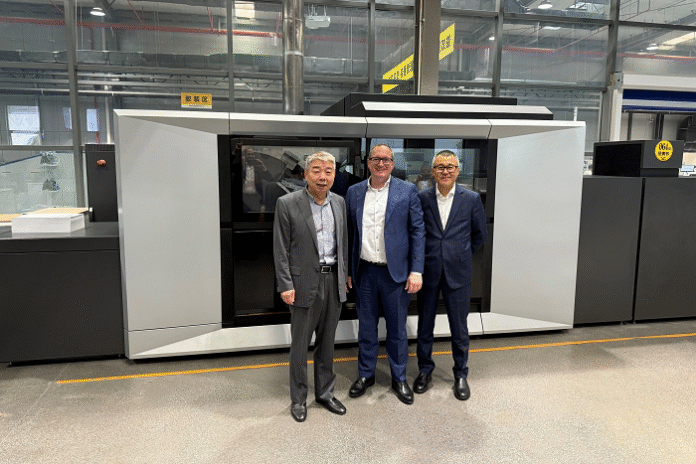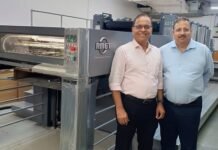
Shengda Printing Technology is China’s largest web-to-print company with a daily capacity to handle 80,000 orders, of which more than 95% orders come through the Internet. A few months ago, it became the first Chinese user of a Jetfire 50 industrial inkjet system from Heidelberg. Since it started using this press in June 2025, Shengda has already produced over 10 million prints on it.
The Heidelberg Jetfire 50 inkjet digital press is actually the Canon IX3200, a proven digital engine that has been in production since 2020. It’s a 1200 dpi press using water-based inks. It takes papers from 60 to 350 gsm. The Jetfire 50 is driven by the Heidelberg Prinect front end or control center that can easily switch jobs between offset and digital presses. It can produce 9,120 SRA3 sheets an hour, equal to around 18,000 A4 pages an hour.
Shengda, which is a very large printer and Heidelberg multicolor offset press user, is undergoing its digital transformation and increasing its focus on digital printing. In addition to digital presses for short-run production, it still produces a large proportion of its orders using sheetfed offset presses in both medium and large formats. Therefore, including its offset presses, the company already has a total of around 200 printing units from Heidelberg in use.
Following its initial experiences with a Jetfire 50 from Heidelberg, the company has now purchased ten more Jetfire 50 inkjet presses to be installed at several sites around China in the coming months. The first two presses of the new order are to be installed in December. The company’s strategic approach is geared toward the efficient mass production of digitally printed short runs.
Color quality, stability, and uptime – key factors in large repeat order
The decision to place the sizable follow-up order was made following intensive testing and comparisons with other technologies available on the market. Shengda was won over by the color quality, and high printing stability of the press and by the Heidelberg ecosystem, and service in China. The Heidelberg global service network provides 24/7 rapid response; in the event of unexpected equipment issues, which is reassuring for the company’s continuous production of a very high number of print orders.
Another advantage is that the Jetfire 50 systems are expected to enable a significant reduction in personnel costs and therefore improve operating efficiency. Using multiple Jetfire presses means Shengda requires between two and three fewer operators per shift. The Jetfire inkjet presses are a key part of the fully automated production lines for digital printing, which are fed directly with web-to-print jobs using the Prinect workflow and its JDF (Job Definition Format) Import function.
For example, Shengda now has a low-cost digital solution for producing short runs that involve high quality and/or customized covers combined with identical inside pages – all in a single pass. “The Jetfire systems’ level of automation and performance is impressive and perfectly matches our vision of a digital future,” says Cui Wen Feng, owner of Shengda Printing Technology. “In the medium term, we are planning to install between 20 and 30 digital production lines. Investing in the Jetfire systems marks a key step toward this goal,” he adds. Shengda has already invested over 300 million renminbi in digital printing technology to date. It prints around six million A4 pages every month and has the potential to produce up to eight million.
“Shengda’s investment emphasizes the strength of our industrial digital printing solutions and the relevance of Jetfire technology for the global market,” says Dr David Schmedding, chief technology and sales officer at Heidelberg. “It also confirms the success of our growth strategy for our core business,” he continues. According to market assessments, the global digital printing market accessible to Heidelberg, including service and consumables, will increase from the current level of around 5 billion euros to 7.5 billion euros by 2029. With this in mind, Heidelberg has expanded its portfolio in both the inkjet and toner segments. This will substantially boost the company’s sales of digital printing solutions.
Configurator for hybrid printing production
Heidelberg now offers interested parties the opportunity to gain a quick insight into the world of hybrid print production on its website with a configuration tool based on their order structure. After entering the print run and number of jobs, interested parties receive a recommendation on which combination of digital and offset solutions best suits their requirements. All options can be compared at a glance.
Heidelberg unveiled the B3 Jetfire 50 inkjet press at drupa24
At drupa24, Heidelberg and Canon announced their partnership in selling the existing Canon B3 VarioPrint IX3200, as the Heidelberg Jetfire 50, and a brand new B2 press, the Canon VarioPress iV7, which Heidelberg has named the Jetfire 75. The Canon IX3200 or the Heidelberg Jetfire 50 can produce 9,120 SRA3 sheets an hour using 1200 dpi inkjet heads and water-based inks on paper from 60 to 350gsm. Canon has been selling this press since 2020, and Heidelberg’s version, the Jetfire 50 was available to order at drupa24 with the first deliveries in Q1 2025.
















